
China Airlines flight details
Airline : China Airlines
Flight No : CI 101
Departure City : Tokyo – Narita (NRT)
Arrival City : Taiwan Taoyuan (TPE)
Equipment : Boeing 777-300ER (B-18053)
Blocked Time : 3h50m
Seat No: 11K
First, China Airlines is the state-owned flag carrier of the Republic of China (Taiwan), and should not be confused with Air China, the flag carrier of the People’s Republic of China (mainland China). The airline was founded in September 1959, the airline has had a relatively unassuming reputation for much of its history. Starting in 2010, it entered the global stage by joining the SkyTeam Alliance.
Its transformation continued in 2014, when it took delivery of its first Boeing 777-300ER. The 777s, followed by its Airbus A350 fleet, came with an improved cabin product in a bid to jumpstart the airline’s competitiveness. These planes feature upscale cabins designed by Taiwanese designer Ray Chen. Following the retirement of its Boeing 737-800s after 2025, the airline will only have lie-flat seats in Business Class across its entire fleet.
Booking China Airlines
I booked this China Airlines flight as part of a one-way Business Class itinerary from Tokyo to Jakarta with a layover in Taipei (Taiwan Taoyuan Airport). For this, I paid JPY112,090 (~ IDR12,000,000 or £650), which wasn’t especially cheap. Despite that, I appreciated that this cost around half of a roundtrip ticket.
During the booking process, I managed to assign seats for myself. China Airlines even has a meal pre-booking service, which I will be covering in the next installment.
Check-in
Around three hours before my flight, I took the shuttle bus from Hotel Nikko Narita to Terminal 2, from which China Airlines flights depart. When I entered the terminal, I was surprised to see how crowded it was. To be exact, the queues for Cebu Pacific flights to the Philippines snaked halfway across the terminal! Wow, what was going on?!
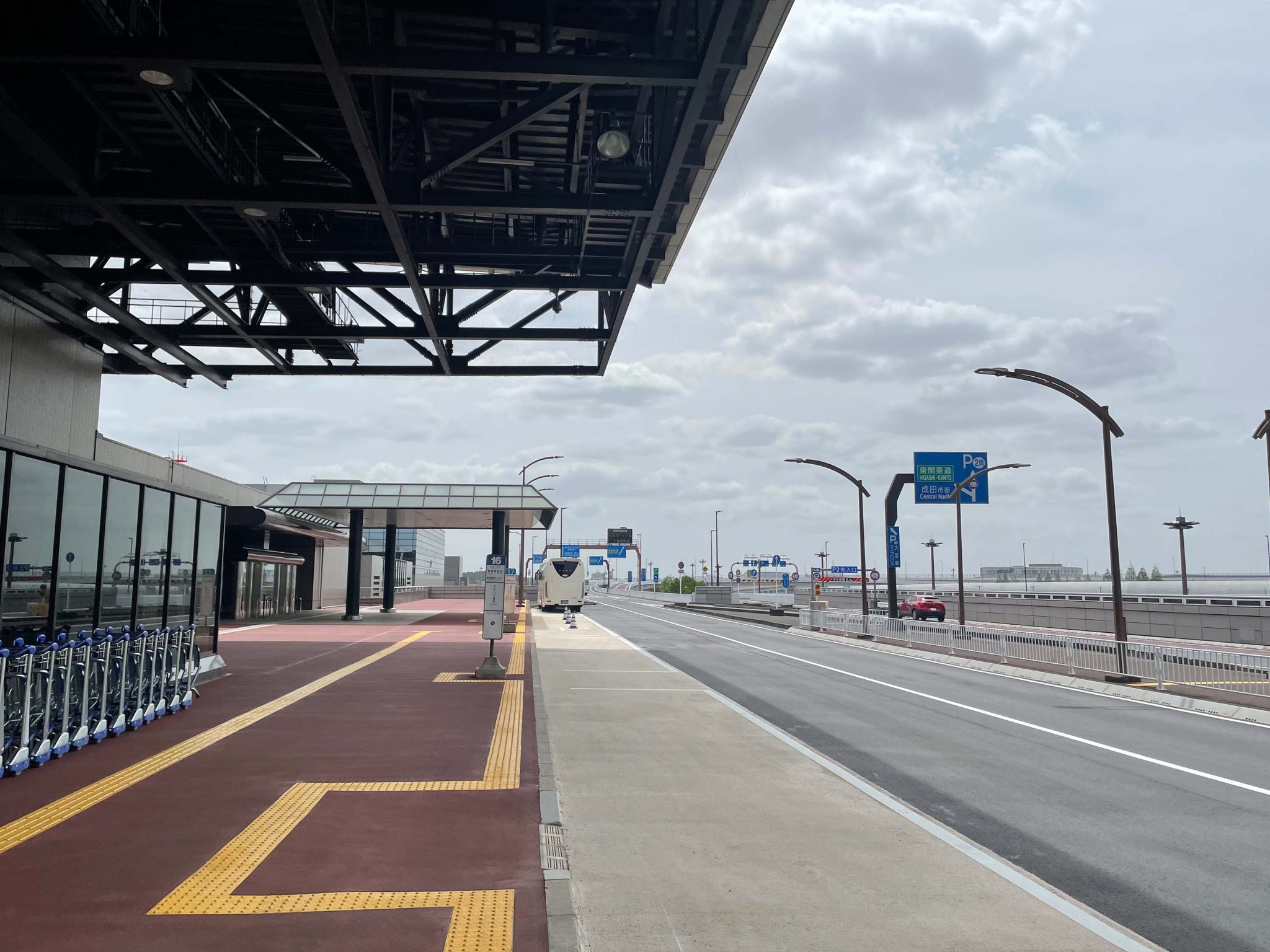
Walking slowly past the throngs of people queueing to fly to the Philippines, I finally made my way to the North side of the terminal for check-in. Specifically, the China Airlines check-in desks are located on Island I, which it shares with Cathay Pacific. When I arrived, the counters were already open, but for the earlier flight to Kaohsiung.

There were dozens of people in line for the general queue, though SkyPriority only had one other person waiting. Nearly everybody checking in appeared to be Taiwanese, which I was quite surprised to see. Within three minutes, a desk became available where I was helped by a warm and friendly agent. After reconfirming that check-in was possible for my flight, she promptly issued my boarding passes. She also gave me a map showing the location of the lounge in the terminal, which was a nice touch!

Lounge
After security and immigration, I headed to the China Airlines Lounge, which I reviewed this lounge in a previous installment. I found it really impressive that they operate their own lounge, even though the airline only consistently has four daily flights. Whilst Narita is home to one more SkyTeam Lounge (the Korean Air Lounge), it is in Terminal 1, and I wasn’t able to head there without a Terminal 1 boarding pass.

Boarding
After about two and a half hours at the lounge, I made my way to the gate. At this point, it was already very crowded, which made sense given the full flight on a 358-seater Boeing 777-300ER. Already in set up at the gate were lines meant for SkyPriority and Economy passengers, respectively

Whilst most China Airlines flights servicing Tokyo feature a Premium Economy cabin, it is sold as Economy on this flight. I guess there isn’t enough demand to sustain a dedicated Premium Economy service from Narita. It only made more sense given how virtually all the passengers on the flight were Taiwanese people flying back home.

Boarding started at 14.00 on the dot, which was the printed boarding time. Having an accurate printed boarding time is truly nice and I don’t understand why airports elsewhere can’t do this. Since there weren’t any preboarding-eligible passengers, Business Class passengers were admitted immediately at this time. I was already in the queue when boarding started and thus became the first passenger to board!


Today’s flight is operated by B-18053, a Boeing 777-300ER delivered new to China Airlines in November 2014. At the door, I was greeted by a friendly flight attendant, who showed me to my seat. As I settled into my seat, a flight attendant greeted me in Japanese, though confusingly, she didn’t understand when I replied in Japanese. Looking at how confused she was, the passenger in front took the liberty to translate my words into Chinese, before she understood what I said. Thereafter, we only spoke in English… how funny! 😛

China Airlines B777-300ER Cabin
The China Airlines Boeing 777-300ER is equipped with 40 seats in Business Class, in a 1-2-1 configuration. Curiously enough, China Airlines markets this cabin as ‘Premium Business Class’, I guess to make it sound like an even higher offering than normal Business Class?



The seats are the same Collins Aerospace Super Diamond seats you’d find on Qatar Airways and Garuda Indonesia. However, China Airlines’ version has been completely customised by architect Ray Chen, who used lots of warm wooden tones. Unlike the grey and sterile cabins on many other airlines, I found this cabin to be very beautiful – evoking a cosy and intimate feeling. In any case, this is easily one of the nicest-looking Business Class cabins out there!


On the Boeing 777-300ER, Premium Business Class is separated into two cabins. The main cabin takes up the space between Doors 1 and Doors 2, featuring six rows of four seats totalling 24 seats. In the mini-cabin behind that is a further 16 seats, featuring four rows of the same 1-2-1 configured pods.

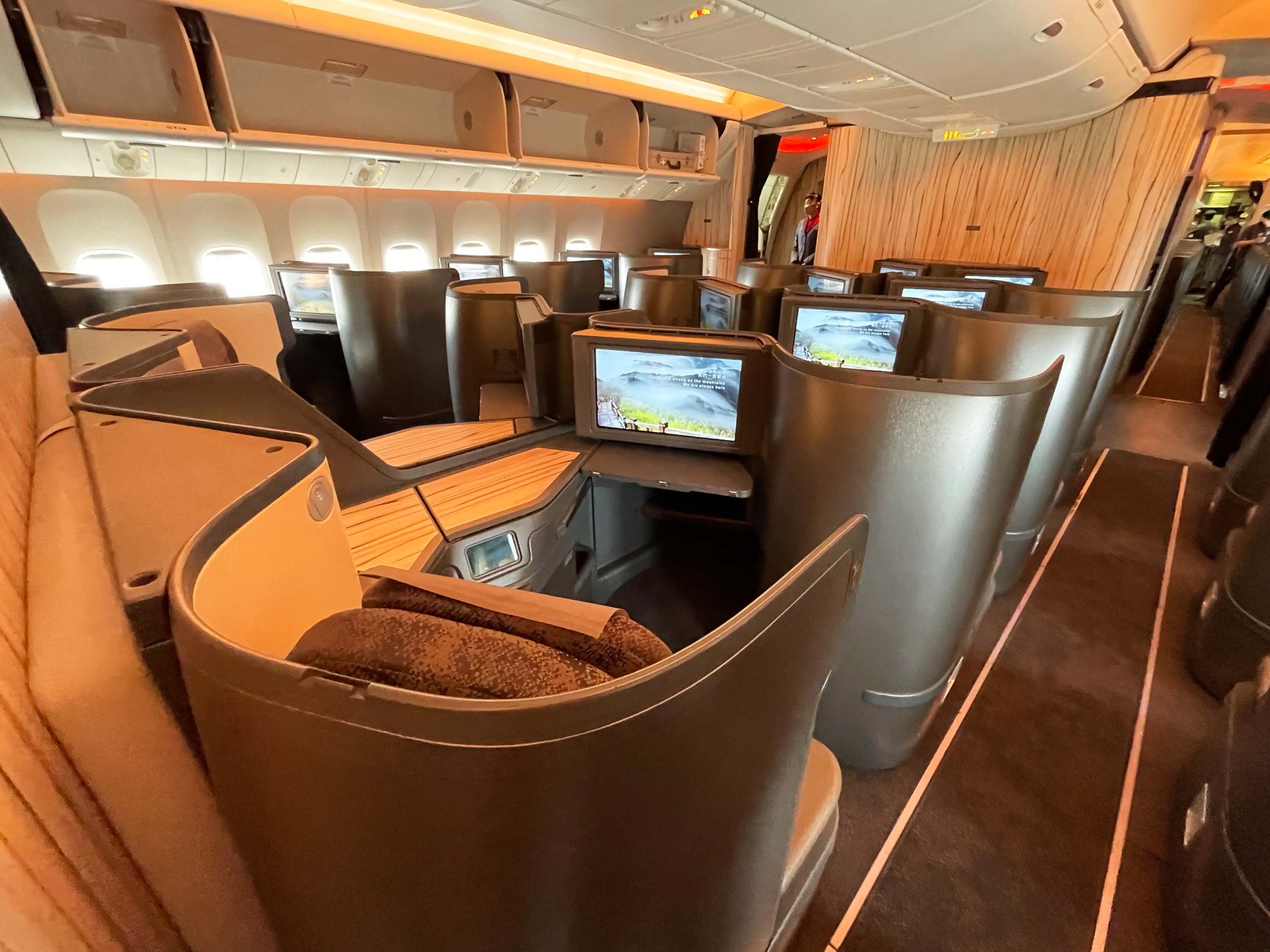

During boarding, I also managed to get a quick peek at the Premium Economy cabin, which looks identical to those on their A350s.

Seat Details
For this flight, I was seated at 11K in the second row of the main Business Class cabin. True to its name, the seats felt very premium both in terms of build and design. For one, due to the width of the Boeing 777-300ER’s fuselage, the seat felt very wide and spacious.

I was really impressed at how the designer was able to strike a balance between having the seats look extravagant and calm at the same time. The plush-looking seat is upholstered in a beautiful, semi-luminous fabric and features a lot of padding. Already waiting on the seat were a velvety pillow and a soft and thick blanket.


By the window side is a wide table surface which also features an elegant-looking table lamp, complementing the regular reading light on the side of the seat. I think this is a very stylish addition to the seat, which I’ve only otherwise seen in British Airways First Class.


The side table surface opens up to reveal two shallow storage cabinets. The deeper cabinet of the two houses the entertainment remote control, the power outlet, and two USB-B plugs, as well as the headphones. It could also easily store a novel and a pair of glasses. The second compartment could only fit a phone, a passport, or a very thin book.

Across from the seat is an 18′ television screen, which is touchscreen and responsive. The tray table pulls and folds out from under the screen into a very sturdy surface.

Seat storage cabinets
To the side of the seat are two additional storage cabinets. The first is located in the aisle-facing armrest and features a cabinet big enough to fit an amenity kit and a water bottle. This armrest can also be extended upwards to function as an additional ‘shield’ from the aisle inflight.

Finally, under the side table is a small compartment that is shaped to fit a water bottle.

Separately, there is also an opening under the ottoman that could conveniently fit a pair of shoes. Bear in mind, however, that this opening cannot be used to store bags during takeoff or landing.

Departure from Narita
After around 15 minutes, the front doors were closed with Business Class fully occupied. By this time, the crew came around the cabin to offer a glass of mixed juice (supposedly mango and pineapple?). Whilst there wasn’t a choice of beverages, I didn’t mind since the juice tasted super fresh and high-quality. Yum!

They then came around to distribute hot towels – when I said hot, I meant steaming hot! Yow!

Following that, the menus for this flight were handed out, after which the flight attendants came back to take our meal orders. Noticeably and very unexpectedly, Champagne isn’t a beverage option! They had a sparkling wine in place of that, which seems like such an oversight for a Business Class service on a supposedly premium route like Tokyo.

The remaining doors closed at 14.24, 24 minutes after boarding started. After the ground staff exited the aircraft, the cabin manager made a boarding announcement in Chinese, then English, then Taiwanese Hokkien (I think). She announced our flight time of 3 hours and 20 minutes and that masks are required, still. The safety video was then played.

We pushed back at 14.31, one minute past our scheduled departure time of 14.30. An automated announcement in Japanese was then played as we taxied to the runway, passing many interesting planes!







After a very long taxi, passing that smorgasbord of aircraft, we finally got to runway 16R. We took off at 14.53, into a grey and cloudy sky…

Inflight Entertainment
As we ascended into the skies, I finally took the time to browse their inflight entertainment system that’s called FantasySky. They had a total of 120 movies in English, Chinese, Japanese, and Korean amongst other languages, which is quite impressive. Of those, 14 were new releases, though I wasn’t interested in any of them. It’s not as great as Singapore Airlines or Qatar Airways, but you could definitely do worse. In addition, whilst the entertainment screen was very responsive and intuitive, the headphones were of merely mediocre quality.

As a complete opposite to my Vietnam Airlines flight to Tokyo, there were no inflight magazines on offer. Instead, there were two shopping catalogues available, which I thought was quite odd. WiFi was also available on this flight and had reasonable pricing ranging from USD3.25 for a messaging plan to a USD21.95 24-hour plan.

Meal Service
The crew were up 10 minutes after takeoff and quickly started preparing for the meal service. As we experienced a lot of moderate turbulence at this time, the seatbelt signs remained on well into the flight. Only at 1h40m after takeoff did the seatbelt signs finally get turned off. What a relief!
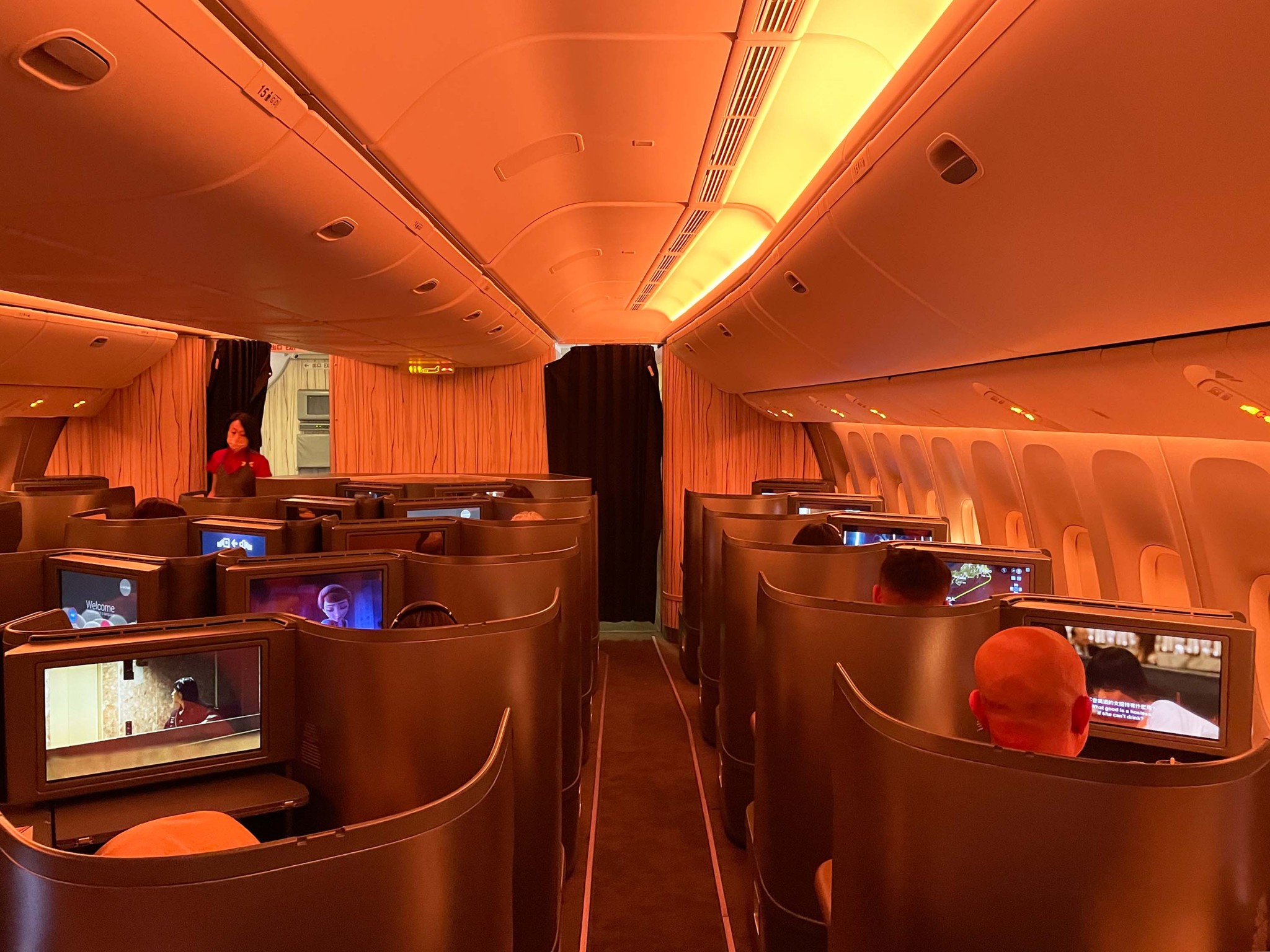
Anyway, before the service started, the crew closed all the windows and turned on the mood lighting. Whilst the cabin looked beautiful as a result, this really messed up my body clock as to what time it was.

At 15.19, 26 minutes after takeoff, table service started, featuring the after-takeoff beverages ordered earlier and a pack of mixed snacks. For this, I had a hot cup of Alishan Green Tea, which in retrospect might not have been the best choice… the weather at this point was still pretty bad. My cup of tea even spilled as a result!


Shortly after this, the main meal was served. There were two types of cuisines on option, including ‘Fusion Cuisine’ and Japanese food. ‘Fusion Cuisine’ seemed to be a mix of Chinese and Western dishes, with a choice of Chicken in Oyster Sauce or Grilled Beef Fillet. Since I already prebooked the Taiwanese option for my next flight, I didn’t think twice and asked for the Japanese option. For reference, the inflight food and beverage menu read as the following.
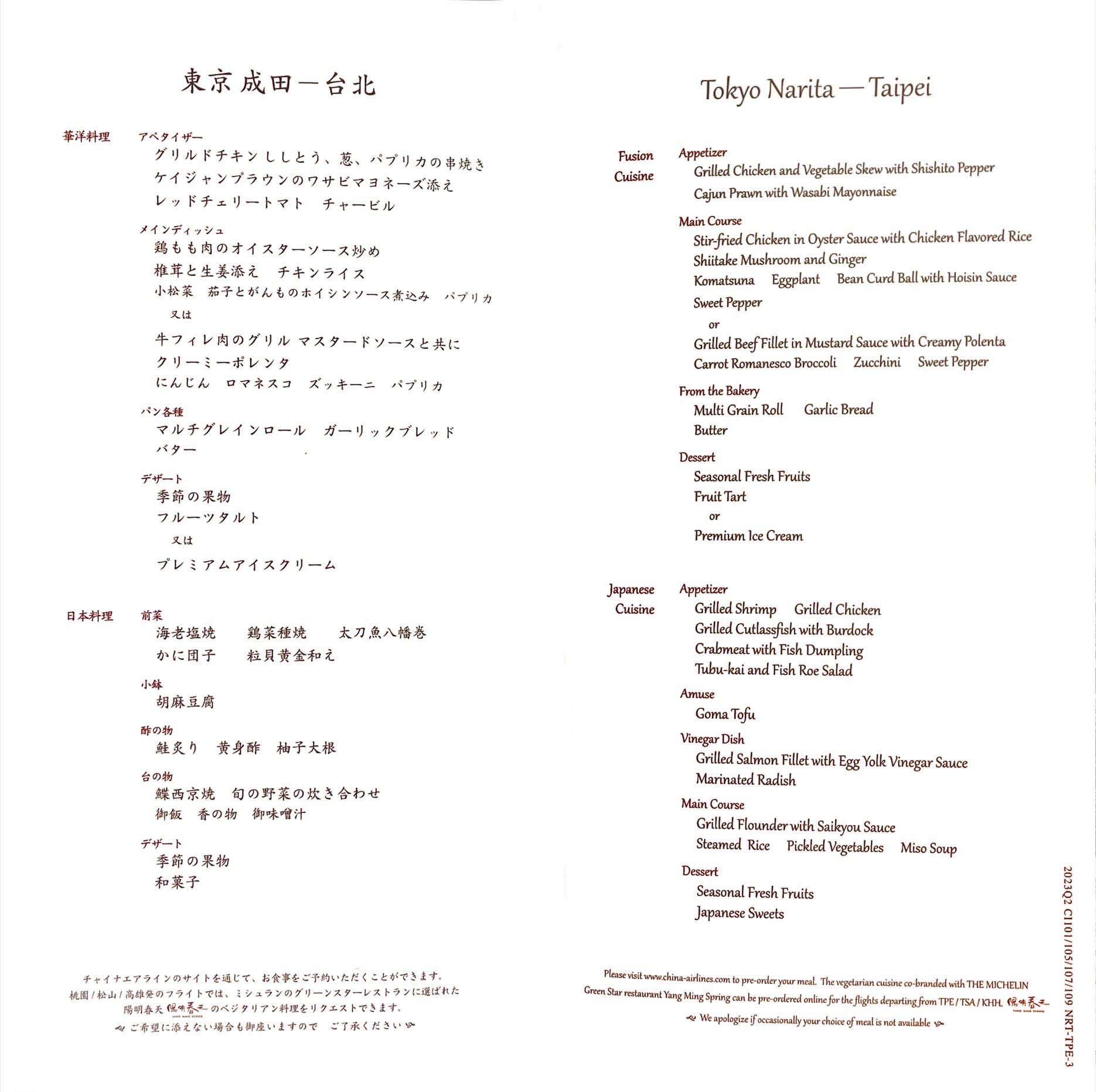
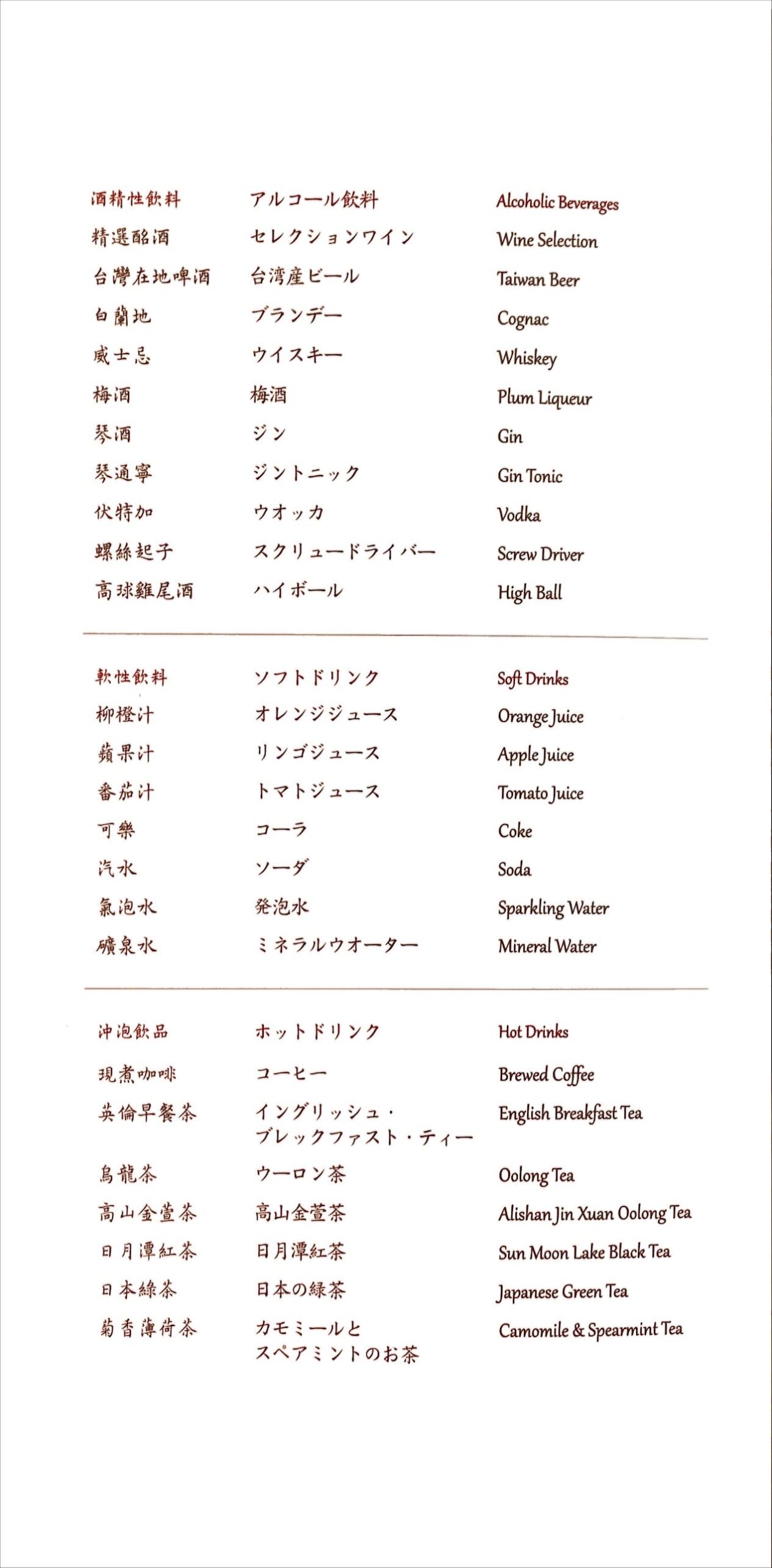
Japanese Meal
The Japanese meal was served on a tray, Teishoku-style, and had the dishes contained in two containers reminiscent of a bento box. These were served with white rice, miso soup, and a side of pickles.
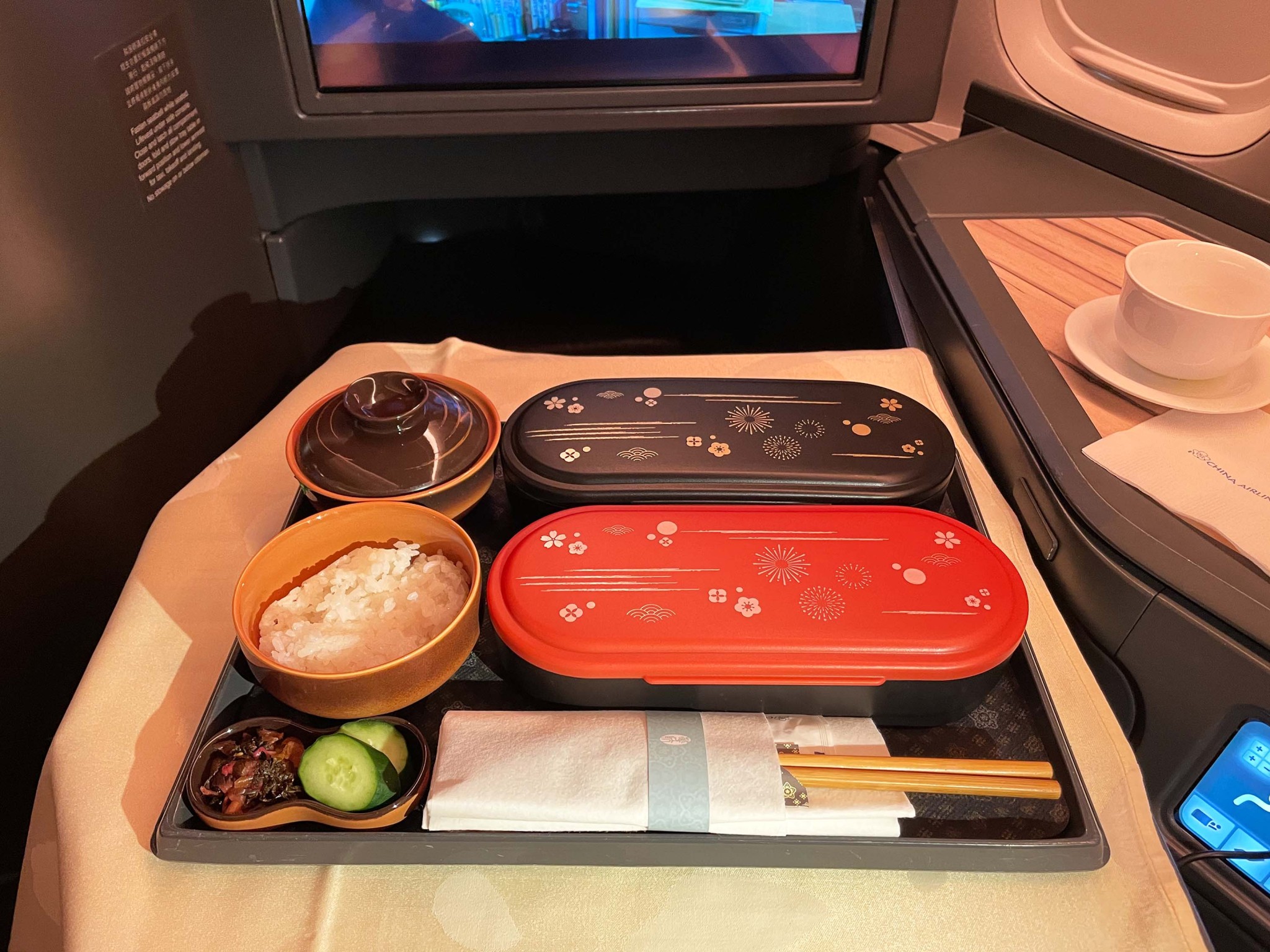
The first container featured the zenzai (appetiser) of salt-grilled prawns, grilled chicken, burdock rolled in cutlass fish, crab dumplings, and a salad, which were all served cold. It also has the kobachi (small dish) of gomadofu (sesame seed tofu), which was absolutely divine.

The next container has the dainomono (main dish) of Saikyo miso-grilled flounder, served with simmered sweet potato and bamboo shoots. Next to it was also the pickled dish of salmon with pickled daikon. Now, to say the main dish was phenomenal would be an understatement because it was out of this world. The flounder was very rich and melted in my mouth. In fact, the quality of each dish is absolutely tip-top and I’d even dare say this would rank high in my Top 3 Business Class Meals of all Time list. Despite having no champagne, China Airlines, you’ve redeemed yourself!!
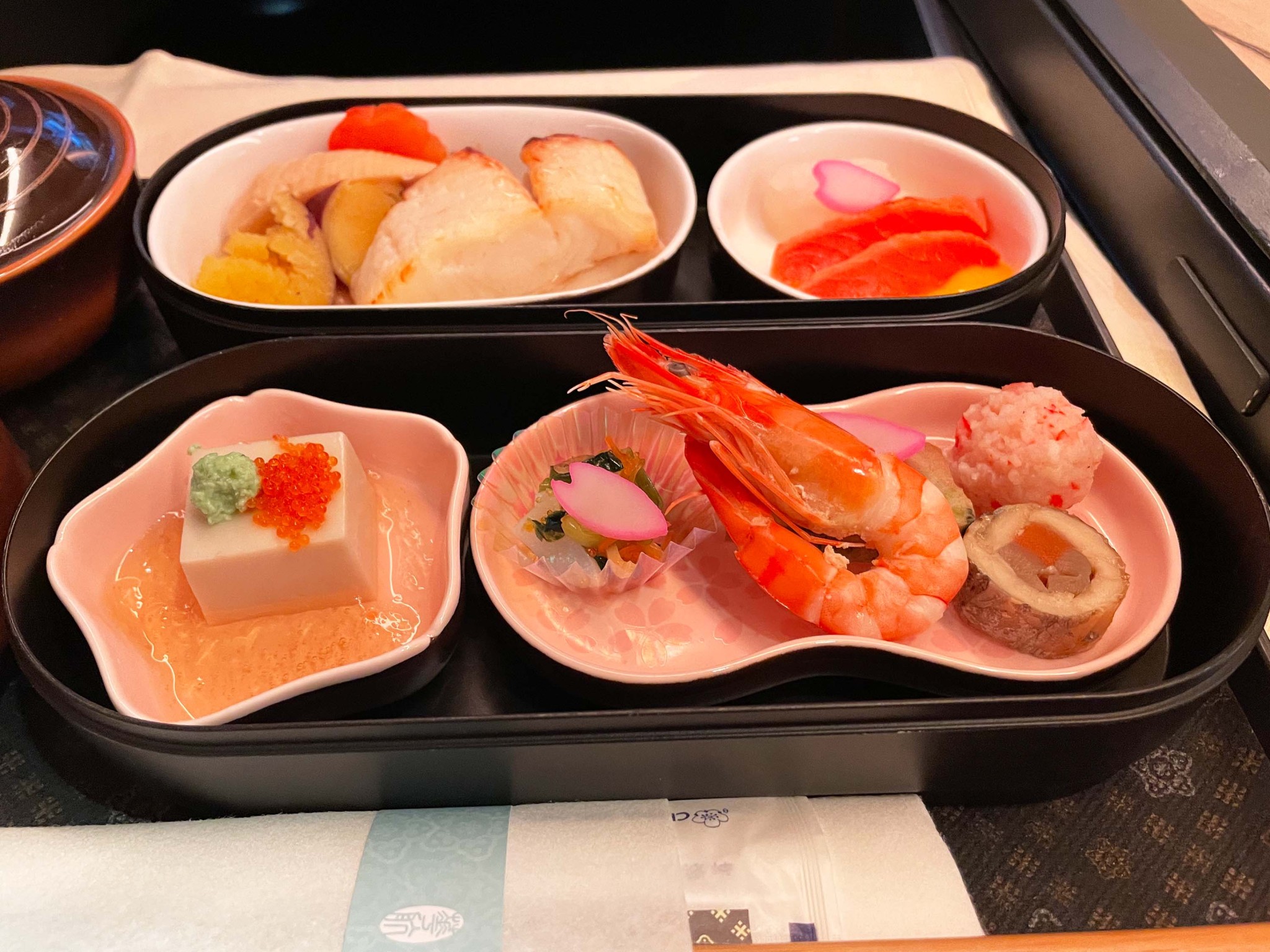

Throughout the meal, the crew would come by my seat and offer drink top-ups, which I really appreciated! When I was done with the meal (trust me, that didn’t take long :P), the tray was also cleared very promptly.
Dessert
Whilst I had green tea for the entire meal, I decided to have a beer at the end of the meal, having forgotten that there was still dessert. The dessert comprised a fruit plate (featuring an orange slice, grapes, kiwi, apple, and Taiwanese guava) as well as a small plate of wagashi (Japanese sweets). Whilst dango and beer were a bit of an odd combination, this was truly an excellent ending to an exceptional meal!


I also noticed that the ‘Premium Ice Cream’ dessert for the Fusion Cuisine set was literally a cup of Häagen-Dazs. I was so glad I picked the Japanese meal!
Lavatory
After the meal, I went to check out the lavatories. China Airlines’ Boeing 777-300ER has three lavatories dedicated to the 40 Business Class passengers, with two located between the cabins and one in the forward section near the flight deck. I found the lavatories to be clean throughout the flight, featuring amenities from Pure Altitude. I liked that the lavatory walls feature a design inspired by Chinese calligraphy, and to add, they even play piano music inside – what a cute touch!


Bed mode
After freshening up myself a bit, I decided to check out the seat in bed mode. The seats are reclined with an intuitive touchscreen control panel by the armrest. As was the case with the seat on my Vietnam Airlines flight to Tokyo, this seat interestingly also has a very slight angle when fully reclined. Despite the angle, it wasn’t noticeable and the bed still felt very comfortable.


I also felt that there was a slight lump on the padding in the waist section of the bed, but it went away after a while. For one, I liked that the footwell is very spacious and didn’t feel constrained at all. In such a sense, it is even completely possible to sleep on one’s side. To make things better, the cabin was kept cold throughout the flight. Combined with the thick blanket provided, it made for a very nice sleep experience on an intra-Asia flight!

Service
For the most part, I found the crew on this flight to be very hardworking. They also had excellent attention to detail, evident through the frequent offers for drink top-ups. I noticed that they communicated in a very friendly and charming manner with Taiwanese passengers (in Chinese). Having only communicated with them in English, however, the crew did seem a bit reserved and distant – although I imagine this to be the definite result of an obvious language barrier. In any case, I had no complaints about the service!
Arrival in Taiwan Taoyuan
At about 36 minutes before our expected arrival time, the captain made his first announcement regarding the start of the descent. He interestingly has a Singaporean accent, which I wasn’t expecting from China Airlines. Regardless, he announced that we would be landing 15 minutes past 17.00, five minutes early. After his announcement, a video from the Taiwan Customs Administration was played, as is standard on Taipei-bound flights.

The seatbelt signs were then turned on 28 minutes before landing, which seemed awfully early. The safety checks, however, were only conducted 15 minutes before landing. It was only by this time did the seats needed to be returned to the takeoff position and the window shades to be opened.

We approached from the north and flew past a few industrial estates before reaching the runway, as seen in the picture below. Also, the windows were all scratched up, making it a bit difficult to get a clear picture.

We landed at 17.12 on Runway 23R, eight minutes before our scheduled arrival time. The touch-down felt very soft and light, which feels so nice after a turbulence-ridden flight! After landing, the cabin manager went to the intercom to welcome us to Taiwan, again, in three languages. We then taxied past the airport’s long-delayed Terminal 3 project before pulling into a gate next to a Singapore Airlines Boeing 787-10.
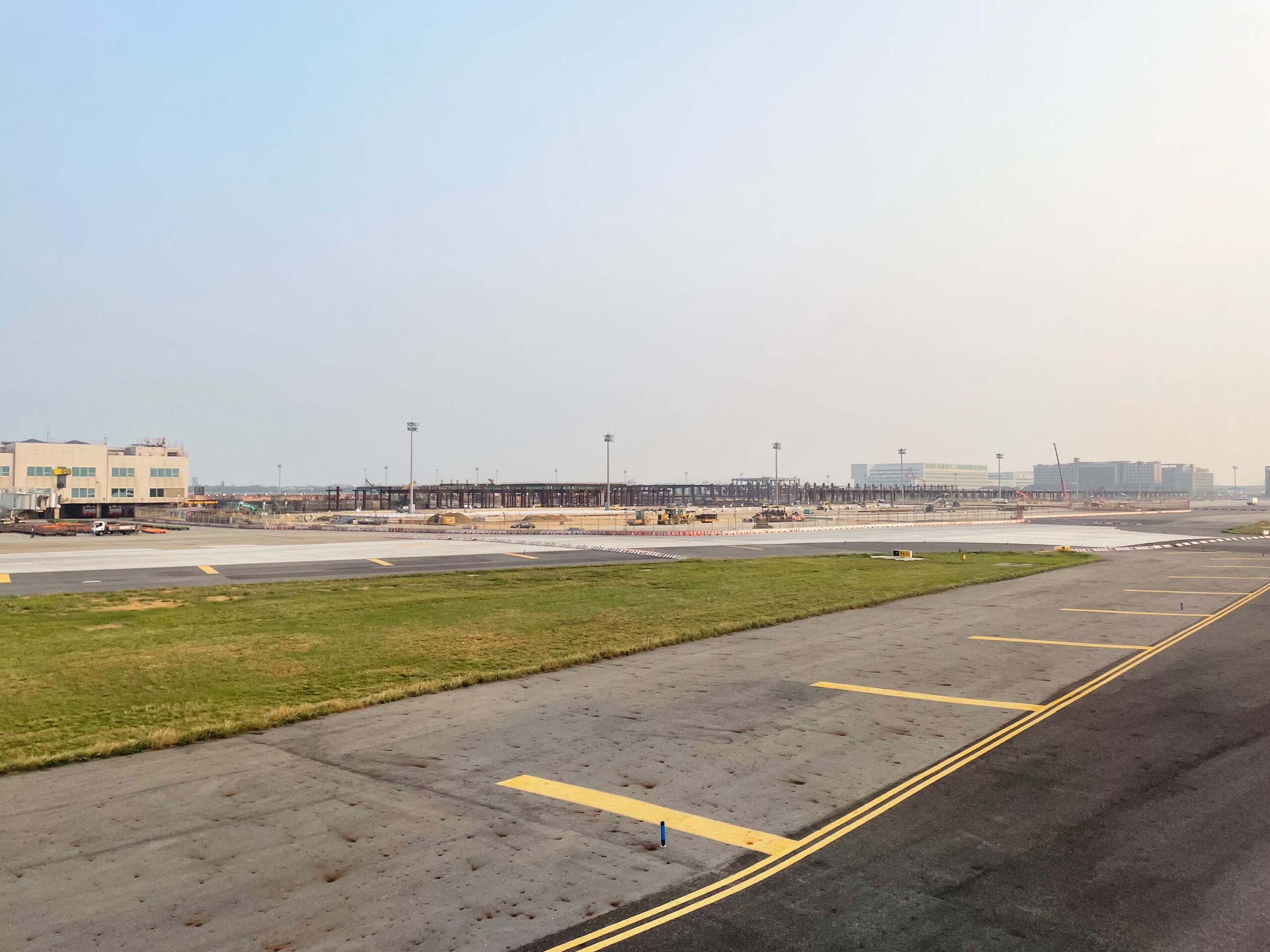
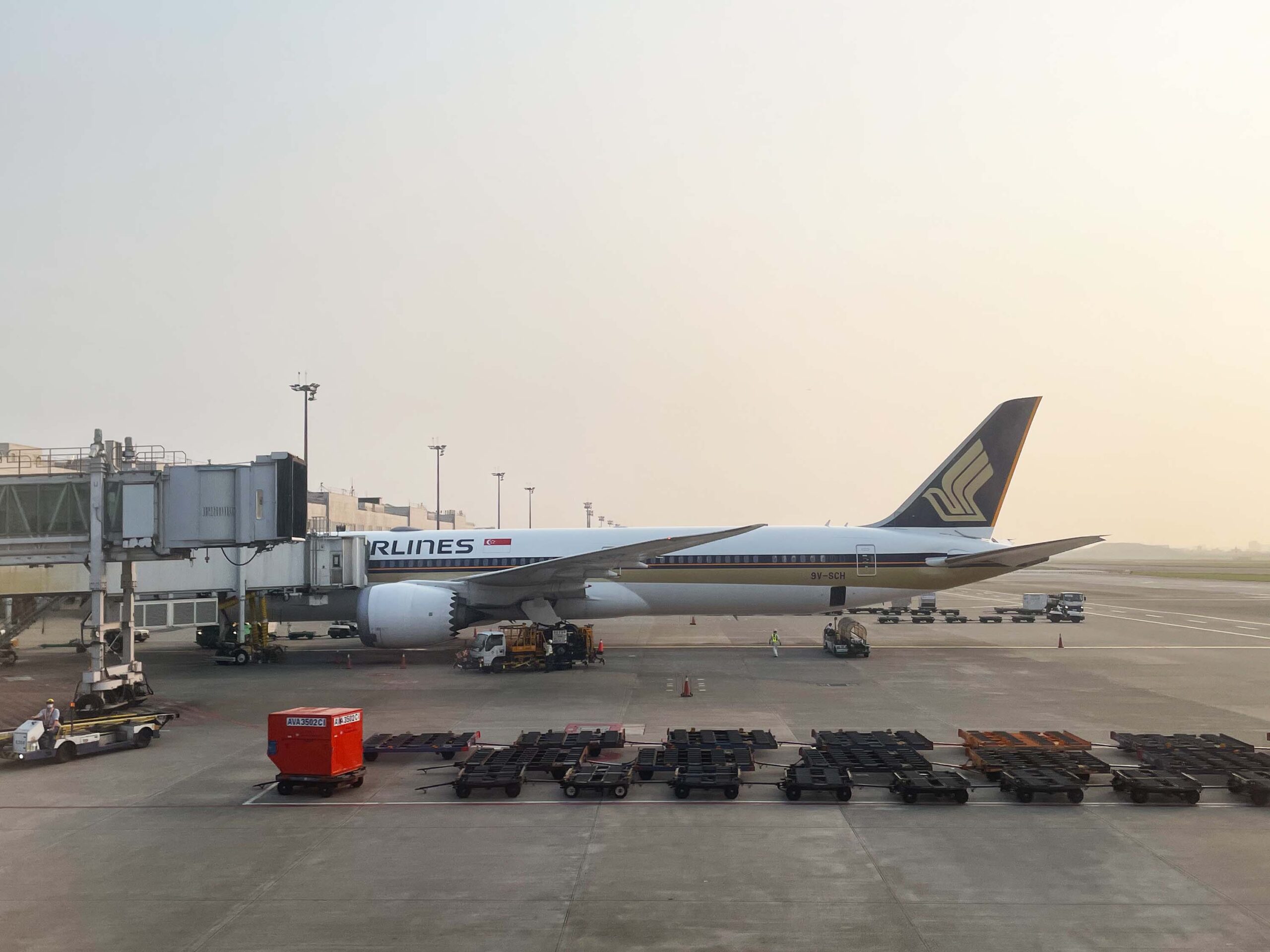
As I disembarked from Door 1L when the doors opened at 17.22, I thanked and bid farewell to the crew before starting my (not so) epic 15-hour layover at Taoyuan Airport!

Verdict
Honestly, I had an excellent time flying China Airlines Business Class on this flight from Tokyo Narita. What truly sold me was definitely the food, which was amongst the best I’ve had on any airline in Business Class. However, I did think that the omission of Champagne on Asia routes honestly feels like a cheap move on the part of China Airlines. If it weren’t for that, I would easily put this amongst the world’s top Business Class products, given the stunning cabin and the incredible food. Truly, well done!

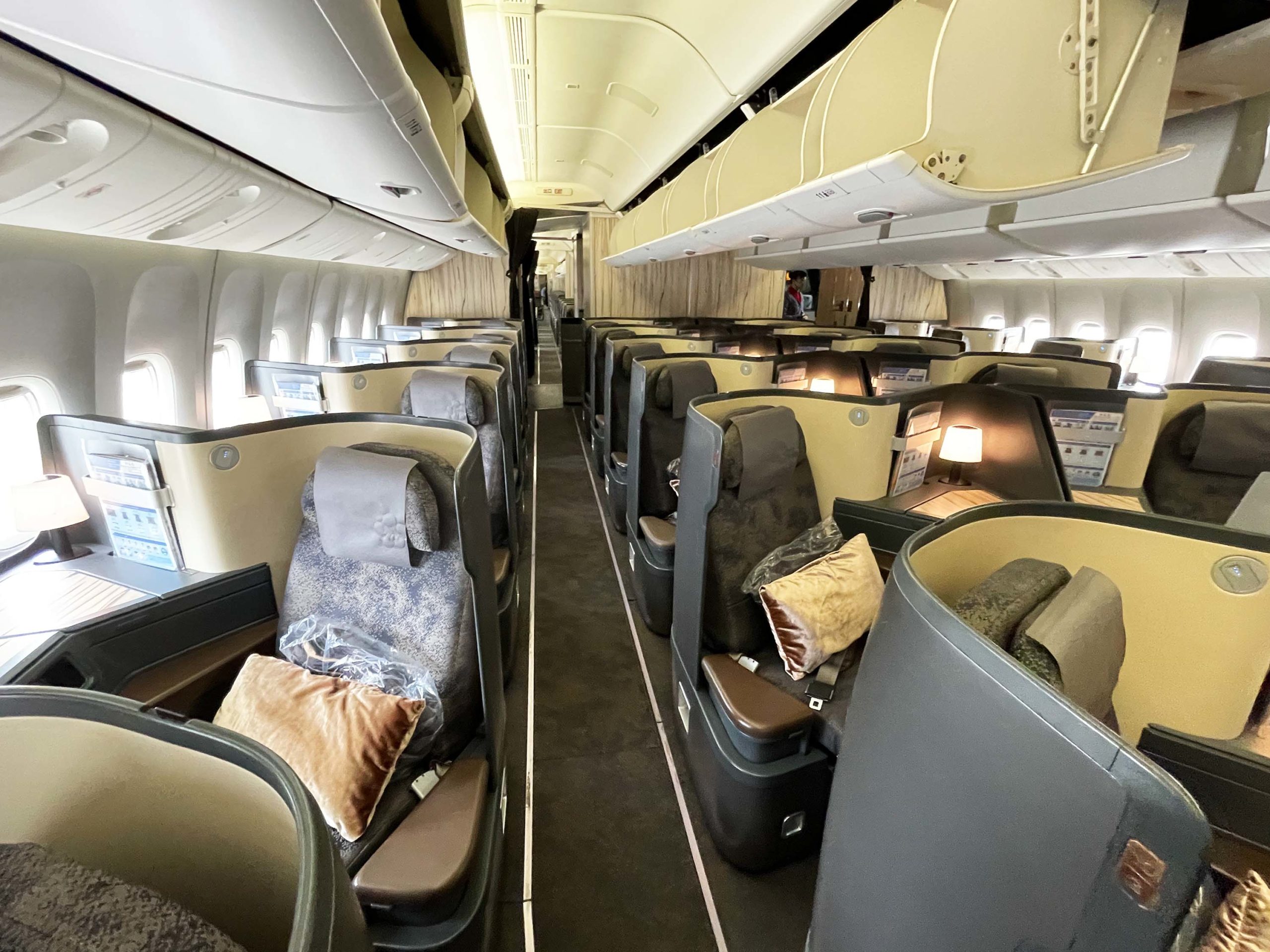
Leave a Reply